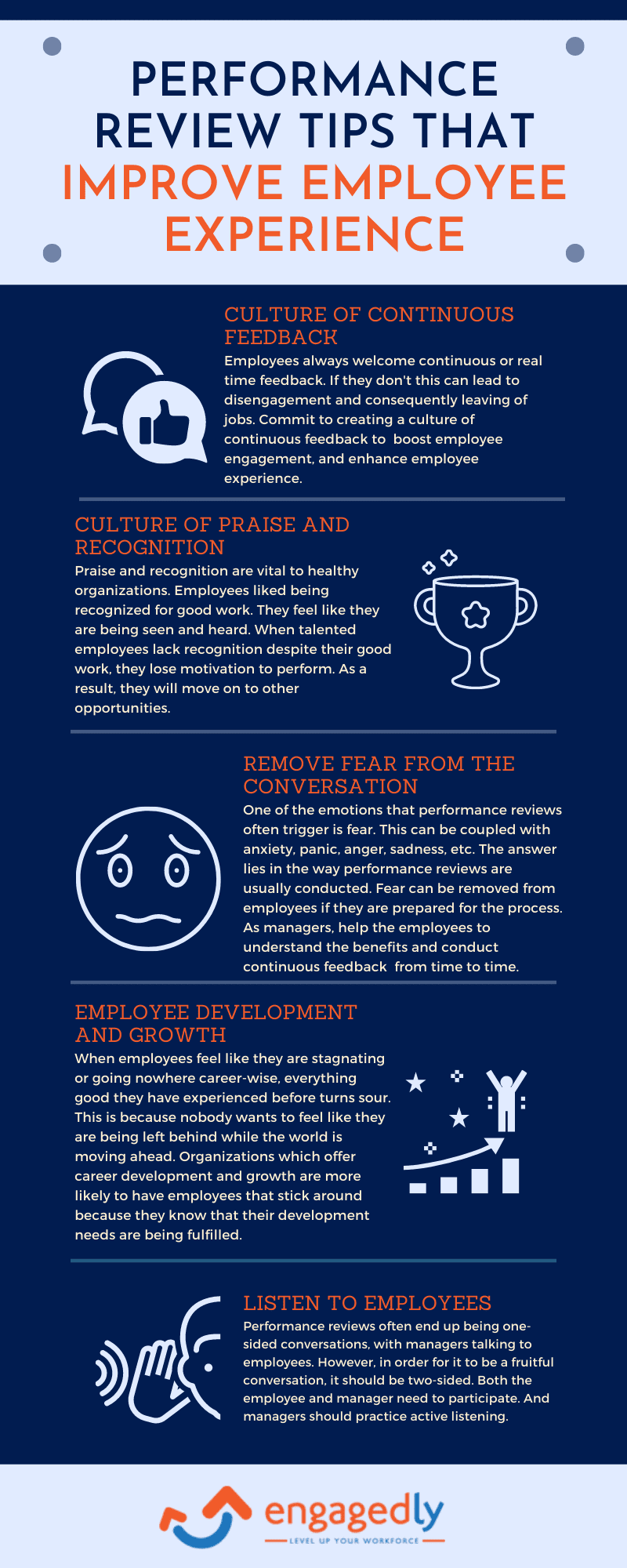Not everyone is a big fan of performance reviews. Managers and employees dread it alike. And studies show that most leaders find it a sheer waste of resources.
But then, why does every other organization conduct employee performance reviews?
The answer lies in understanding its importance. In today’s competitive work environment, an effective employee performance evaluation system is crucial for retaining top talent and boosting engagement.
Employee performance review, or performance evaluation, isn’t just a process of identifying the most talented employees and rewarding them; it is about creating a performance-driven, data-backed, and employee-centered culture that helps employees and organizations accomplish bigger goals.
Research has shown that organizations that conduct effective employee performance evaluations are 1.4 times more likely to meet their financial goals, have a more engaged workforce (2.7 times), and are 4 times more likely to encourage appropriate risk-taking.
Effective employee performance evaluations help employees and teams improve their performance and lead organizations to better business outcomes In this article, we will understand the intricacies of employee performance reviews and discuss the following:
What is an Employee Performance Review?
An employee performance review, or performance evaluation, is an assessment conducted by a manager to review the overall performance of an employee during a particular time period. The review provides managers with an opportunity to discuss the employee’s strengths, weaknesses, and opportunities.
It is a two-way conversation that generally involves asking questions, offering feedback, setting goals and expectations, and making a rational and empirical analysis of an employee’s overall contributions.
A comprehensive employee performance evaluation allows for honest discussions on areas where employees excel and where they can improve
A performance review is meant to leverage the talent by offering them guidance, appreciating their efforts, motivating them to perform better, and discussing the learning and development opportunities to enhance their skills.
It is a process that helps managers identify the potential of their employees and offers a constructive approach to guide them on the path of their highest potential.
Performance evaluations serve multiple functions in organizations, but the most rudimentary among them are:
- Ensuring effective communication and providing feedback to employees
- Help change or alter the behavior of employees so as to make them more productive and aligned towards organizational goals
- Planning for future assignments and projects based on the data gathered during the employee review process
- Through a well-structured employee performance evaluation, organizations can identify skill gaps and provide targeted training for personal and professional growth.
For a long time, organizations have relied on traditional performance reviews of conducting annual assessments, but with the change in the global business market, most organizations are moving towards a continuous review process.
Companies like Google, Adobe, Microsoft, and Accenture have completely replaced their traditional review systems with a more frequent and accessible process. It usually involves conducting frequent check-ins, providing on-going feedback, and establishing clear communication between managers and employees.
Performance Review Process Flowchart
The following infographic highlights the complete performance review process followed by organizations.
Types of Employee Performance Review
Performance reviews are constantly evolving. What was once a top-down approach has now metamorphosed into a holistic, continuous, and dynamic process. Though the top-down approach is still in practice, it is loaded with inconsistencies that cause disengagement among employees.
A more practical approach towards employee development and engagement is to conduct continuous performance reviews. Frequent employee performance evaluations help managers and employees stay aligned on goals, reducing any surprises during annual reviews.
As modern HR strategies talk about improving the employee experience, it is important to incorporate a wholesome and action-oriented review approach that helps employees in their personal and professional development.
Overall, organizations use different types of reviews to rate the performance of their employees. You can refer to the below list to understand which process will be more effective and suitable for your organization.
1. Annual Performance Review
A form of traditional review wherein a manager and employee discuss the various aspects of employee performance once a year. It usually takes into consideration the annual accomplishments, contributions, and challenges of an employee and offers feedback based on the discussion. Most organizations are transitioning from annual reviews to more frequent and actionable processes.
Also Read: Problems with annual performance reviews
2. Semi-Annual Performance Review
Held twice a year, once at the beginning and the other one towards the middle of the year, semi-annual performance reviews provide opportunities for adjustments in the plan and to take corrective action, if required.
3. Quarterly Employee Performance Review
Quarterly reviews help managers take quick action on the performance of their employees and make adjustments to the plan during the review meetings. It is a more proactive approach towards improving employee performance.
4. 30 60 90 Day Employee Performance Review
30 60 90 Day performance review is a review process used specifically for new hires during their probationary period. Managers assess the performance of new employees on their 30, 60, and 90 day anniversaries and offer them support to easily transition into their new roles.
5. 360 Performance Review
In a 360 performance review, employees get feedback from the people they deal with quite frequently. It usually involves input from the manager, direct reports, clients, vendors, customers, and employee self rating.
It is one of the most effective ways to understand the strengths, weaknesses, and behaviors of employees that affect their performance. Using a platform like Engagedly for employee performance evaluations can streamline the process and provide real-time feedback to employees.
6. Peer to Peer Performance Review
It is a multi-rater approach in which co-workers review the performance of their peers and evaluate them on their skills, competencies, behaviors, attitudes, and various other aspects. Peer to peer review provides a holistic view of employee performance and helps weed out any bias and inconsistencies.
7. Employee Self Evaluation
It is a form of review in which employees assess their own performance during a particular time period. By highlighting their aspirations, goals, and challenges at work, employees give a fair view of how they think and feel about their work.
As per Arthur Worsley, Founder, The Art Of Living, employee self evaluation is becoming more integral to the efficacy and effectiveness of performance reviews. It allows management to understand where it’s doing well and where it needs to improve, according to the employees.
They are a great way to determine the essential areas each individual employee needs further support in. The more effective your support provision, the more likely that your employees’ performance will improve and the more likely you’ll be able to retain them for the long term.
Also Read: Performance Review Phrases And Wordings To Use
Benefits of Performance Review
The purpose of conducting performance reviews is multifaceted. It helps in setting a performance benchmark and evaluating employees against it. It helps managers identify their most potential employees and those whose performance is not on par with the set standard. Furthermore, managers use reviews to understand employees’ personal ambitions and align them towards organizational objectives.
Performance appraisals help employees evaluate their own performance and provide them with comprehensive feedback to hone their skills and alter their attitudes and behaviors for higher performance and productivity.
Conducting continuous performance reviews can be extremely beneficial to your organization. Effective, planned, and structured reviews can help achieve the following:
- Maintain a record of employee performance and use it to create a customized development plan for every employee
- Identify strengths and weaknesses of employees and assign them projects based on this knowledge
- Create a performance plan at the beginning of the year and set clear expectations
- Enhance employee engagement by making employees a part of the organizational journey
- Increase performance and productivity by motivating employees
- Improves communication between employees and managers
- Improves organizational effectiveness and efficiency in achieving goals and objectives
Organizations that value employee performance evaluations tend to see higher engagement, as employees feel their contributions are recognized and valued.
Performance Review in a Hybrid Workplace (Process)
Effective performance reviews can lead organizations towards success. It helps increase employee engagement, productivity, and the overall efficiency of the organization. Furthermore, it helps both managers and employees improve relationships and collaborate to achieve higher goals.
But then why do most managers and employees feel uncomfortable just with the idea of a performance review?
According to a survey conducted by Gallup, only 14% of employees agree that performance reviews inspire them to improve. Another report by Deloitte found that 58% of HR managers think of performance reviews as an ineffective use of time.
Traditional performance reviews with a top-down approach do more harm than good. Most leaders believe that traditional performance reviews are ineffective and actually make the performance worse about one-third of the time.
Max Wesman, Chief Operating Officer at GoodHire, views traditional performance reviews as ineffective and a waste of important resources. As per him, traditional performance reviews, which were once a cornerstone of the workplace, have since faded into obscurity as the global workplace takes shape and adapts.
Most workers resent the performance review process—as do many managers—owing to its focus on punishing and reprimanding rather than fuelling positive change. In response, formal appraisals have since been gradually replaced with frequent, informal check-ins that reward employees for productive behavior rather than chastise them for past mistakes.
The challenges of employee evaluations have been further aggravated by the hybrid work environment.
Most managers haven’t met their team members in-person, which leads to biases and unclear perceptions about their performance. With a growing number of employees opting for remote and hybrid work, it becomes increasingly difficult for managers to provide fair and accurate evaluations of their employees.
To ensure consistency and fairness, HR teams often design standardized employee performance evaluation criteria that align with company goals.
If you are facing similar challenges, then follow the below employee performance review process to conduct meaningful employee evaluations in a hybrid workplace.
Create a Standard Employee Evaluation Criteria
To avoid any bias and inconsistencies creeping into the process, it is better to create standard evaluation criteria. Managers should discuss the criteria with employees before the start of the year. HR managers and leaders must ensure that every employee is aware of the performance evaluation process being followed by the organization.
Bonus Tip: Use a real-time performance management system like Engagedly to create a standardized process for employee evaluation.
Review Employees Based on Their Monthly, Quarterly, or Annual Goals
Evaluating employees based on the achievement of their goals is the best way to conduct performance reviews. Whether your employees work remotely or from office space, setting and tracking goals helps keep their efforts aligned in one direction.
Moreover, employees have something to look forward to every day. They are clear about their tasks and responsibilities and know that their performance appraisals will be based on the goals discussed during the performance planning process.
Bonus Tip: Use aspirational and committed OKRs to monitor the performance of your employees.
Use 360-Degree Feedback for a Comprehensive Performance Review
Using 360 degree feedback provides employees with a more equitable, fair, accurate, and holistic review of their performance. It also helps in eliminating personal bias as there are multiple reviewers in the process.
In fact, research has shown that feedback from peers is more effective at improving performance and enhancing engagement in the workplace.
Bonus Tip: 360 degree feedback should be conducted every quarter to monitor changes in an employee’s performance and provide them with guidance to overcome any challenges.
Use Performance Management Systems to Track Employee Performance
A performance management system like Engagedly helps in continuous tracking and analysis of employees’ performance and provides insights to leaders to take appropriate action. It provides an overarching mechanism for evaluating performance, creating customized learning paths, and developing talent towards optimal performance.
Tips for Conducting Effective Performance Reviews
Just like an effective employee evaluation review drives performance, an ineffective one leads to disengagement and can even leave employees feeling disconnected from the organization. It is therefore important to understand how to effectively conduct performance reviews that support employees and encourage them to work towards their betterment.
The crux of conducting employee reviews is to create a conducive environment that encourages employees to openly talk about their achievements, challenges, aspirations, and inhibitions.
Managers must ensure that they provide a positive environment for their employees to ask questions and be more involved in the review process.
The following tips will help both managers and employees get the most out of their review discussions.
Performance Review Tips for Employees
Be prepared for the review process
Preparation shows that you value the review process and are invested in your growth. Take some time beforehand to think about your recent projects, accomplishments, and any challenges you’ve faced.
For instance, if you worked on a significant project, come ready to discuss the role you played, the skills you utilized, and how it impacted the team or company goals. Being prepared will make you feel more confident and help you share your achievements clearly.
Keep records of accomplishments handy
Having records of your achievements makes it easier to back up your statements. Instead of relying on memory, jot down highlights as they happen. For example, if you received positive feedback from a client or solved a tricky problem, note it down in a digital or physical file.
During the review, you can refer to these records to remind both yourself and your manager of the contributions you’ve made. This shows initiative and makes it easier for your manager to assess your impact.
Listen carefully and ask for clarification
Reviews can sometimes cover areas for improvement, which can be hard to hear—but listening carefully is essential. If your manager mentions a skill to work on, don’t hesitate to ask for examples to understand their perspective.
For example, if they say, “I’d like to see you improve your communication with other departments,” you might ask, “Could you give an example of a time I could have communicated better or a specific way I can improve?” This shows that you’re committed to growth and open to constructive feedback.
Ask more questions to have a clear and effective discussion
Asking questions not only makes the review more productive but also highlights your desire to improve. You might ask about areas you haven’t received feedback on before.
For example, “How do you feel my problem-solving skills have developed over the last quarter?” or “Are there additional skills you think I should focus on?” This can open up the conversation, allowing you to learn about expectations and opportunities for growth.
Discuss your personal and professional goals
Your review is a perfect time to align your career goals with the company’s objectives. Be honest about where you’d like to go within the organization.
For instance, if you’re interested in moving into a leadership role, share that. You could say, “I’d love to grow into a project lead role eventually—do you have any advice on skills I should work on to make that happen?”
Managers appreciate employees with vision and a willingness to plan for the future.
Ask for help in areas you need improvement
Everyone has areas to improve on, and being proactive about asking for help shows humility and a growth mindset. For example, if you’re struggling with a particular software tool, mention it and ask if there are resources to help you improve.
You could say, “I’ve noticed that I could be more efficient with [software/tool]—is there a training or a resource you’d recommend?” This approach not only shows your commitment to excellence but also opens the door to helpful support from your manager.
Also Read: How to conduct performance review for managers
Performance Review Tips for Managers
Prepare for the review meeting
Preparation shows respect for the employee’s work and time. Before the meeting, go over the employee’s recent projects, the feedback they’ve received, and your own notes. Think about specific points you want to discuss and jot them down so you’re organized.
For example, if an employee led a successful project, be ready to acknowledge their effort and anyways they exceeded expectations. This preparation helps set a constructive tone and makes the meeting more focused and productive.
Keep employee performance notes handy while conducting the review
Having performance notes on hand lets you back up feedback with concrete examples. Rather than giving general feedback, refer to specific instances where the employee performed well or encountered challenges.
For instance, you might say, “In the last quarter, I noticed your strong communication skills during the team presentations, which helped clarify our project goals.” Keeping notes handy allows you to give accurate feedback that feels relevant and meaningful.
Be specific about the feedback
Specific feedback is more actionable and leaves less room for confusion. Avoid vague statements like, “You need to work on communication.” Instead, try saying, “In meetings, I noticed that when you shared project updates, some details were missing.
Being more thorough could help the team stay aligned.” This gives employees a clear idea of where to focus their efforts and provides a path for improvement.
Talk about behaviors and attitudes that help employees excel
Highlighting positive behaviors and attitudes can reinforce what’s working well and motivate employees.
For example, if an employee consistently shows initiative, acknowledge it: “I’ve seen how proactive you are in tackling issues before they escalate—it’s a quality that strengthens the whole team.”
This positive reinforcement encourages them to continue those behaviors, building a stronger team culture.
Keep compensation out of the review
Separating compensation discussions from performance reviews helps keep the focus on development. It allows employees to concentrate on growth, feedback, and career goals without being distracted by financial discussions.
If compensation is brought up, gently redirect: “Today’s meeting is all about your development and goals. We’ll discuss compensation separately to give each topic the focus it deserves.”
Cite instances and examples of both good work and areas of improvement
Balance your feedback with both positive reinforcement and constructive examples. For example, if an employee exceeded expectations on a recent project, highlight it specifically.
Conversely, if they missed a deadline, explain how it impacted the team’s workflow. Specific examples—both positive and constructive—make the feedback feel genuine and well-rounded.
Be more empathetic and involved
Empathy goes a long way in helping employees feel valued and understood. Approach each review as a conversation rather than a one-way critique. For instance, ask, “How do you feel about your current workload?” or “Are there any challenges I can help you with?”
This shows you care about their well-being and fosters a supportive environment where employees feel safe to discuss issues and aspirations.
Learn how to write performance reviews effectively
Written performance reviews should be clear, structured, and constructive. Invest time in learning how to frame your feedback in writing so it reflects what you discussed in person.
Use a balance of positive observations and constructive points, and end with a note on future goals. For example, “In the next quarter, let’s work on increasing your project management skills.
I believe this will play to your strengths and give you more opportunities for growth.” A well-written review reinforces the conversation and gives employees a document they can refer back to.
Employee Performance Review Best Practices
There is a fine line between an effective performance review and a bad one. When done right, performance evaluations lead to motivation, goal alignment, and enhanced productivity and engagement.
On the contrary, a badly conducted review can stray your employees from the path of optimal performance and can even lead to disengagement and frustration among them.
A performance review is an opportunity for both managers and employees to create bridges and find ways to overcome challenges and celebrate accomplishments. That’s why it is suggested to conduct frequent reviews rather than wait for problems to grow bigger.
Without proper execution, performance reviews fail to fulfill their purpose and eventually lead to a waste of time and resources. The review process laid out in the previous section, along with the below performance review best practices, will help to get the most out of the discussions.
Prepare for the review meeting beforehand: Keep performance records, accomplishments, awards, and other related documents handy. If you use a performance management system to keep track of employee performance, then make sure to go through the performance history before starting the review meeting
- Create a positive and collaborative environment to help employees open up during the review process
- Use the continuous feedback approach to avoid anxiety during the review. It will further strengthen the ties between managers and employees and help establish a two-way communication system between them
- Be specific while giving feedback. Cite examples of good and bad performance. Use action-oriented statements instead of generic ones
- Use the right tools to conduct a virtual review
- Understand how to conduct performance reviews for remote employees
- Use the right employee performance review phrases that engender motivation, discussion, and keep bias out of the process
- Take a look at employee performance review examples to learn how to make the review more effective
- Use the right performance review software
- Learn how to give a negative performance review
- Document review in writing for future reference
- Do not compare your employees
- Connect with employees frequently
- Follow up after the review meeting
Also Read: 5 Ways to improve performance review process
Employee Performance Review Template
A performance review template helps conduct effective reviews in a strategic and action-oriented manner. A customizable template allows reviewers and human resource managers to make adjustments to include/exclude the evaluation parameters and create a standard performance review form for employees.
Depending upon the areas of assessment, you can use different evaluation forms to have open and two-way communication with your employees. Furthermore, it helps keep track of employee performance records in one place and can be used during appraisals.
A performance review template should be
- Clear, concise, and easy to follow
- Provide an in-depth analysis of the evaluation parameters
- Offer insights to gauge the overall employee performance
- Assist in the development and career planning of employees
Concluding Words
Performance reviews don’t have to be dreadful. Instead, they should motivate and empower employees to make strategic changes to be more productive and resourceful for the organizations. Only by making reviews continuous, ongoing, and action-oriented can organizations get buy-in from employees and use the data insights to leverage their talent and achieve higher goals.





















